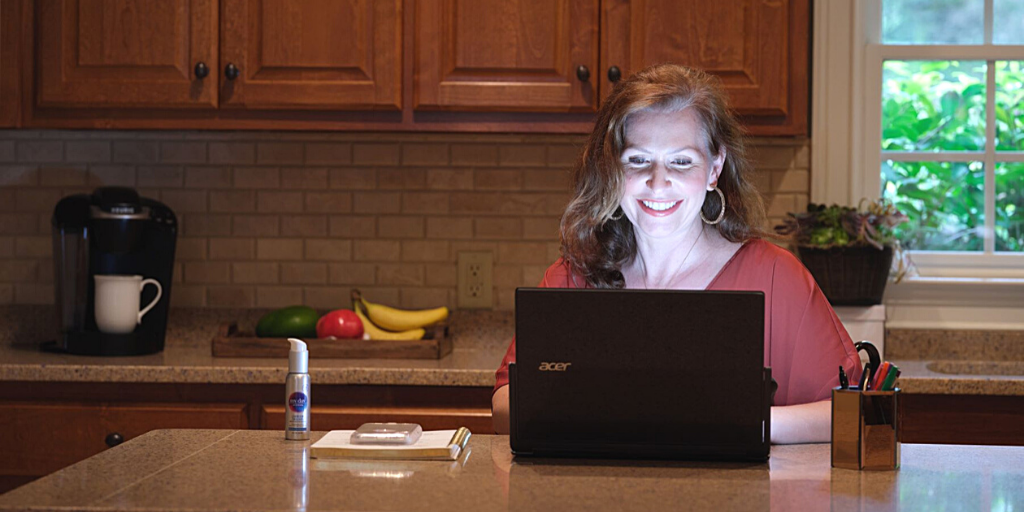While attending a Cosmetic Chemists conference on sunscreen, I heard a dermatologist say something I will always remember. She said that when she walks into her exam rooms, she can immediately tell which side of the face her patients predominantly hold their cell phones. She said the cell phones were emitting blue light that damages our skin. After the session I went to the bathroom, looked in the mirror and noticed brown spots on the right side of my face where I hold my phone. Uh oh!

Fortunately, when I heard the presentation, I was well on my way to creating formulations (i.e., Tinted Drops) that can reduce our skin’s exposure to blue light or HEV (high energy visible) light as it is also know. Even before the conference, I was aware of the dangers of blue light to our skin through my research and had planned to bring awareness of and remedy to this concern.
After working with my R & D team to create the Tinted Drops—a plant-based, mineral formulation with a silky feel, I had the products tested for blockage of blue light transmission. The test results showed that the Light/Medium Tinted Drops reduced transmission of blue light by 56% and the Fair/Light Tinted Drops reduce transmission of blue light by 62%. These tests were conducted in independent labs in addition to the SPF and Broad Spectrum testing.
In addition to the blockage of blue light, the antioxidant ingredients in our formulations reduce the impact of the oxidative stress that results from blue light damage.
What is the damage that blue light can cause to our skin? Most of us have heard that blue light can damage our eyes, but fewer know about the risks of blue light exposure to our skin. In fact, doctors and clinicians provide blue light treatments for various skin conditions including acne, psoriasis, and removal of pre-cancerous lesions.1
In small doses, blue light exposure at specific wave lengths can be beneficial to destroying diseased cells, but increased doses and penetration of blue light can damage good cells.

While the research on the damaging effects to our skin from exposure to blue light through our electronic devices and interior lighting is new and emerging, it is revealing some serious concerns. Here is a snapshot of some research findings on blue light damage to the skin from man-made devices:
- HEV contributes to signs of premature photoaging due to oxidative stress (i.e., imbalance of free radicals and antioxidants).2
- In addition, man-made sources of visible light, such as (computer) screens or LED lighting contribute to skin damage.3 Source: Merino, M.; Mullor, J.L.; Sánchez-Sánchez, A.V. Medaka (Oryzias latipes) Embryo as a Model for the Screening of Compounds That Counteract the Damage Induced by Ultraviolet and High-Energy Visible Light. J. Mol. Sci.2020, 21, 5769.
- Extensive exposure times to artificial sources of blue light through the use of electronic devices can be considered to cause cellular alterations and oxidative stress, harming skin cells.4 Source: Lorrio S, Rodríguez-Luna A, Delgado-Wicke P, Mascaraque M, Gallego M, Pérez-Davó A, González S, Juarranz Á. Protective Effect of the Aqueous Extract of Deschampsia antarctica(EDAFENCE®) on Skin Cells against Blue Light Emitted from Digital Devices. Int J Mol Sci. 2020 Feb 2;21(3):988.
- Reduced proliferation and oxidation damage may contribute toward premature photoaging in skin with prolonged exposure to blue light.5 Source: Jakhar, Deepak, Kaul, Subuhi, Kaur, Ishmett. Increased Usage of Smartphones during COVID-19: Is that Blue Light Causing Skin Damage?
- Studies suggest that exposure for even one hour (at 1 cm distance) can cause generation of ROS in fibroblasts leading to premature skin aging. 6,7 Source: Jakhar, Deepak, Kaul, Subuhi, Kaur, Ishmett. Increased Usage of Smartphones during COVID-19: Is that Blue Light Causing Skin Damage? J Cosmet. Dermatology 2020;19:2466-2467.
I am convinced that our electronics are damaging our skin. I wear My Day Screenv Light/Medium Tinted Drops to reduce transmission of the blue light coming from my phone and computer. I also wear it because the plant-based ingredients found in our Tinted Drops have healing properties. In addition to all the healthy benefits of the Tinted Drops, I wear it because it looks and feels good on my face.
I hope you will consider the benefits of My Day Screen® Tinted Drops and try one of our two shades. You will be protecting your skin and nourishing it at the same time. It truly is suncare that feels like skincare.
REFERENCES
- Magali Bonnans, Linda Fouque, Michele Pelletier, Rachel Chabert, Sandrine Pinacolo, Laura Restellini, Karine Cucumel, Blue light: Friend or foe ?,Journal of Photochemistry and Photobiology B: Biology, Volume 212, 2020, 112026, ISSN 1011-1344.
- Liebel F, Kaur S, Ruvolo E, Kollias N, Southall MD. Irradiation of skin with visible light induces reactive oxygen species and matrix-degrading enzymes. J Invest Dermatol. 2012 Jul;132(7):1901-7. doi: 10.1038/jid.2011.476. Epub 2012 Feb 9. PMID: 22318388.
- Kim, H.J.; Choi, M.S.; Bae, I.J.; Jung, J.Y.; Son, E.D.; Lee, T.R.; Shin, D.W. Short Wavelength Visible Light Suppresses Innate Immunity-Related Responses by Modulating Protein S-Nitrosylation in Keratinocytes Journal of Investigative Dermatology (2016) 136, 727e731
- Rascalou A, Lamartine J, Poydenot P, Demarne F, Bechetoille N. Mitochondrial damage and cytoskeleton reorganization in human dermal fibroblasts exposed to artificial visible light similar to screen-emitted light. J Dermatol Sci. 2018 May 5:S0923-1811(18)30213-5.
- Mahmoud BH, Ruvolo E, Hexsel CL, et al. Impact of long-wavelength UVA and visible light on melanocompetent skin. Journal of Investigative Dermatology. 2010;130(8):2092-2097.
- Austin E, Huang A, Adar T, Wang E, Jagdeo J. Electronic device generated light increases reactive oxygen species in human fibroblasts. Lasers Surg Med. 2018;50(6):689-695.
- Arjamndi N, Mortazavi G, Zairei S, Faraz M, Mortazavi SAR. Can light emitted from smartphone screens and taking selfies cause premature aging and wrinkles? J Biomed Phys Eng.2018;8(4 Dec):447-452.
